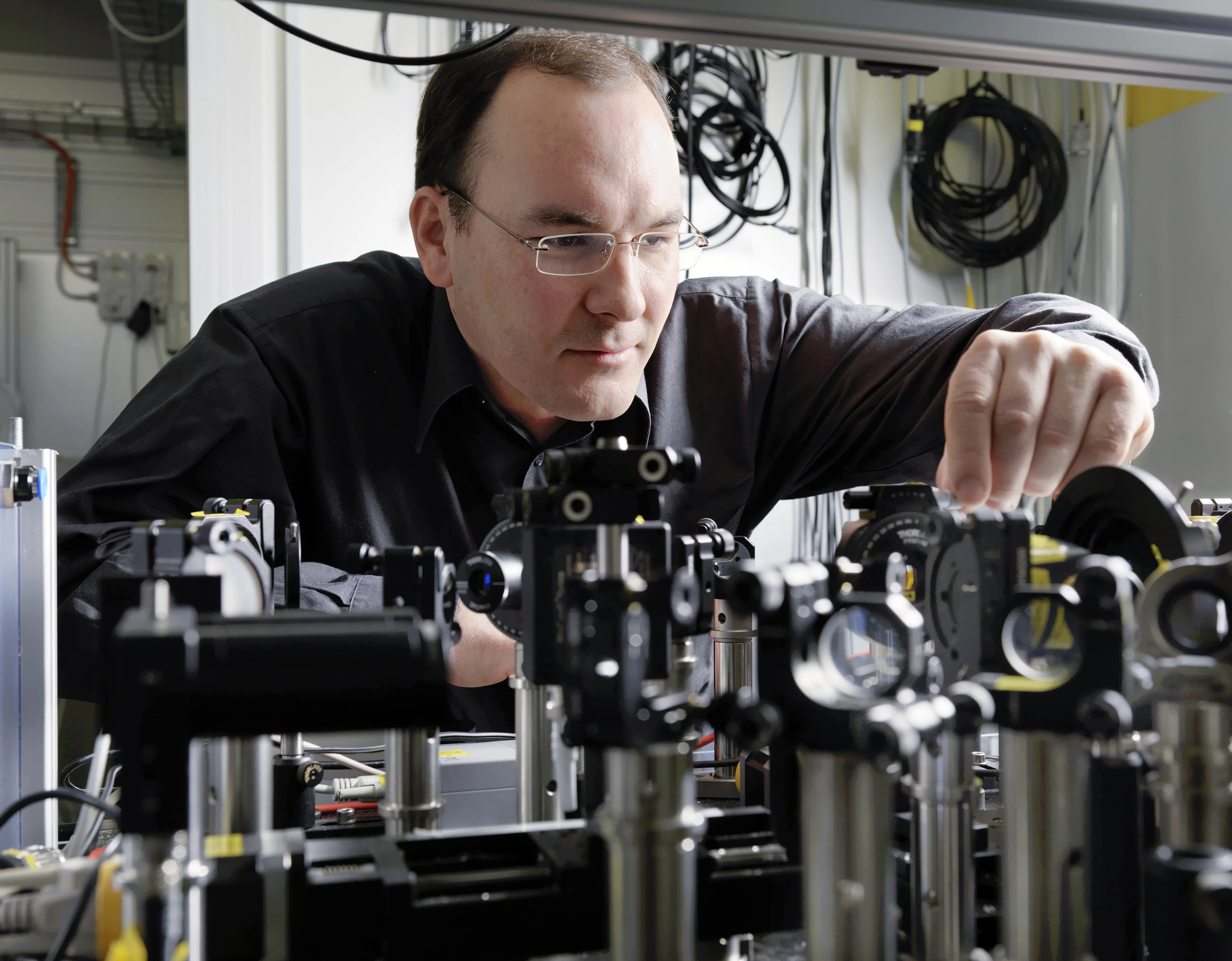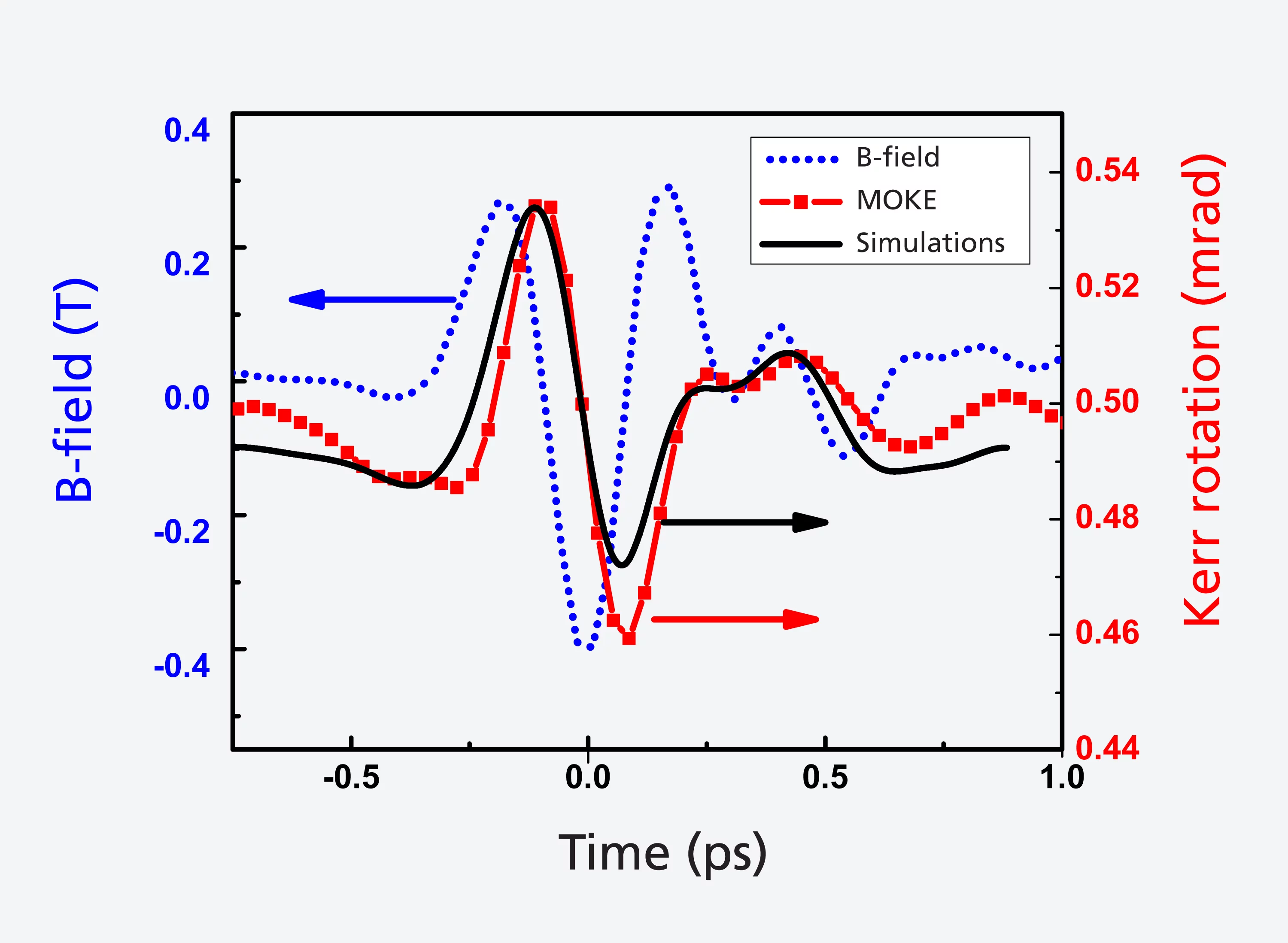A terahertz laser developed at the Paul Scherrer Institute makes it possible to control a material’s magnetisation at a timescale of picoseconds (0.000 000 000 001 seconds). In their experiment, the researchers shone extremely short light pulses from the laser onto a magnetic material, where the magnetic moments – “elementary magnets” – were all aligned in parallel. The light pulse’s magnetic field was able to deflect the magnetic moments from their idle state in such a way that they exactly followed the change of the laser’s magnetic field with only a minor delay. The terahertz laser used in the experiment is one of the strongest of its kind in the world. One special feature is the fact that it is phase-stable, which enables the exact change in the electrical and magnetic field within the individual pulses to be defined reliably for each laser pulse. As the majority of data is stored magnetically these days, the possibility to quickly change a material’s magnetisation is crucial for new, rapid storage systems. The researchers report on their results in the journal Nature Photonics.
follows the laser pulse’s magnetic field with a slight delay. The black curve shows the prediction of a computer simulation.
These days, the majority of data is stored magnetically, such as on harddisc drives. Thus, a bit, the smallest amount of information, is stored in the magnetisation direction of a small section of the storage medium. One might imagine that such a magnetic material contains many miniscule magnets – the magnetic moments. If one wants to change the information, one has to reverse the direction of the moments. And in order to be able to store large amounts of data, one needs processes that enable the magnetisation direction in a material to be changed quickly.
Magnetisation in time with the terahertz laser
Researchers at the Paul Scherrer Institute (PSI) and the Swiss Federal Institute of Technology in Lausanne (EPFL) have now studied a new approach in conjunction with French colleagues at the Université Pierre et Marie Curie in Paris that enables the magnetisation of a material to be controlled at the timescale of picoseconds (0.000 000 000 001 seconds). To do so, they used a newly developed laser that generates very short pulses of light in the terahertz range. Like all electromagnetic radiation, the light consists of an electrical and a magnetic field that both alter their directions very quickly – in the light of a terahertz laser, the direction changes around 1,000,000,000,000 times a second. If you shine this light onto a magnetic material, the variable magnetic field in the laser light can change the direction of the material’s magnetisation – much like if you hold a magnet to one side of a compass needle, then to the other, the difference here being that this realignment takes place within an extremely short space of time: less than one picosecond.
In their experiment, the researchers used extremely short “flashes” of terahertz light. Unlike the light from conventional lasers, terahertz light does not heat up the magnetic sample, which turns out to be essential for an exact manipulation of the magnetisation. The terahertz flashes used were so short that the magnetic field just about had time to point in one direction, then in the other. In the illuminated material, the magnetic moments were deflected as a result: first in one direction, then in the other. They thus followed the change of the magnetic field in the terahertz flash exactly with a tiny delay.
Identical pulses
The terahertz laser was developed by the laser group within the SwissFEL project at the Paul Scherrer Institute. Until a few years ago, there were barely any strong terahertz lasers – there was even talk of a terahertz gap. “We use special organic crystals for our lasers that reduce the frequency of laser light”, says Christoph Hauri, head of the laser group and professor at EPFL, explaining the idea behind the equipment. “If we shine onto the crystal using a strong laser with a high frequency, it emits radiation on a terahertz scale.” The laser is one of the strongest in the world. Another of the laser’s properties important for the experiments is its phase stability, which means that one can specify exactly how the change in the magnetic field within the individual pulse takes place and that this pulse form can be reproduced time and again. The development was made possible thanks to a successful collaboration with Swiss industrial partner Rainbow Photonics AG.
The laser flash in the experiment presented is not yet intensive enough to be able to flip over the magnetisation completely; you can merely observe the dynamics, i.e. the movement of the magnetisation. The experiment, however, is an extremely important milestone for demonstrating the concept of the ultrafast and exact manipulation of magnetism with a laser. Hauri is confident that a complete flip-over of the magnetism can be achieved. “There are tricks to enhance the fields of a weak laser to such an extent that they could switch the magnetisation.” This would also involve selecting a special pulse form and generating a pulse where the magnetic field initially points in one direction weakly, then strongly in the other, then point back in the original direction weakly again. If only the middle strong part of the pulse is strong enough to flip over the magnetisation, one could use such pulses to re-magnetise materials. Such precisely defined pulses are now available at the PSI.
Part of the SwissFEL project
At the Paul Scherrer Institute, the development of the terahertz laser is part of the SwissFEL project, where the SwissFEL x-ray laser is being constructed as the PSI’s new large-scale facility. It will produce laser light on an x-ray scale and thus make many processes visible in the material that are not accessible using today’s study methods. Terahertz lasers are due to be used in two places there. On the one hand, they will be employed for measuring the properties of the x-ray beam in operation. On the other hand, they could be used to initiate reactions in experiments where the intermediate state is to be determined later with the x-ray laser.
About PSI
The Paul Scherrer Institute develops, builds and operates large, complex research facilities, and makes them available to the national and international research community. The Institute's own key research priorities are in the investigation of matter and material, energy and the environment; and human health. PSI is Switzerland's largest research institution, with 1500 members of staff and an annual budget of approximately 300 million CHF.
Contact
Prof. Dr. Christoph Hauri, SwissFEL Laser Group, SwissFEL Project, Paul Scherrer Institute, 5232 Villigen PSI and Ecole Polytechnique Fédérale de Lausanne, SwitzerlandPhone: +41 (0)56 310 4197, E-mail: christoph.hauri@psi.ch; christoph.hauri@epfl.ch
Dr. Peter Derlet; Condensed Matter Theory Group, Paul Scherrer Institute; 5232 Villigen PSI, Switzerland
Phone: +41 (0)56 310 3164, E-mail: peter.derlet@psi.ch
Prof. Dr. Jan Luning, Université Pierre et Marie Curie, 75005 Paris, France
E-mail: jan.luning@upmc.fr;
Original Publication
Offresonant magnetization dynamics phase-locked to an intense phase-stable THz transientC. Vicario, C. Ruchert, F. Ardana-Lamas, P.M. Derlet, B. Tudu, J. Luning and C.P. Hauri
Nature Photonics, Advance Online publication, 11 August 2013
DOI: 10.1038/nphoton.2013.209


